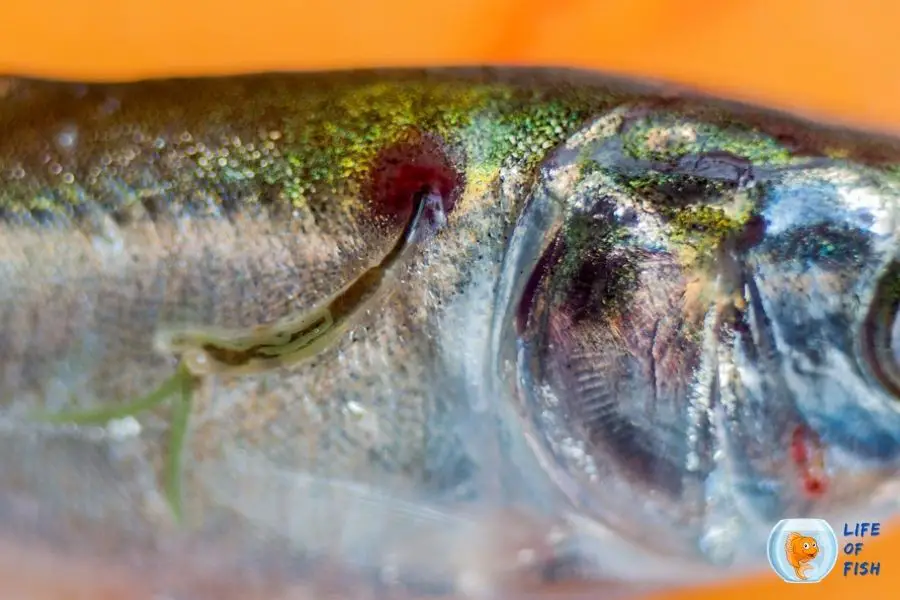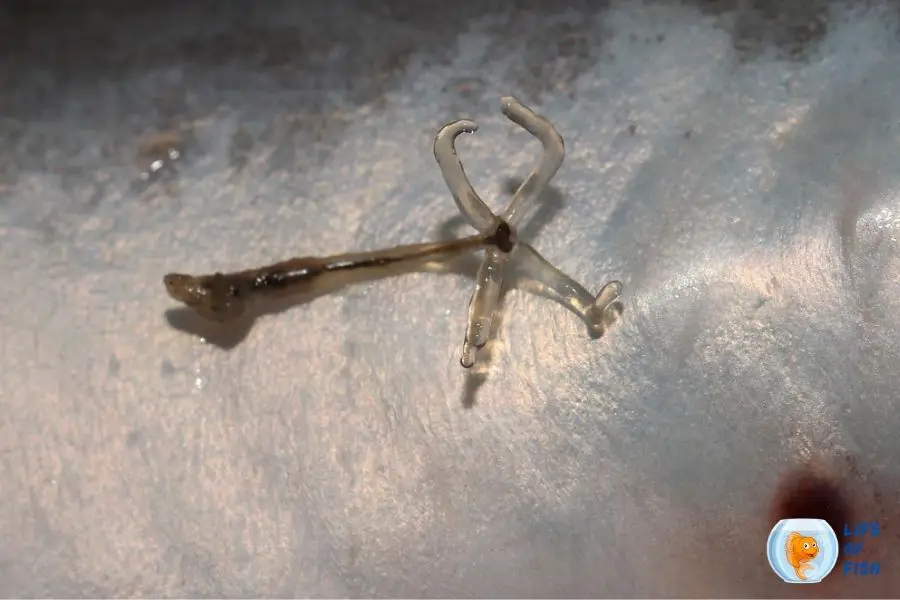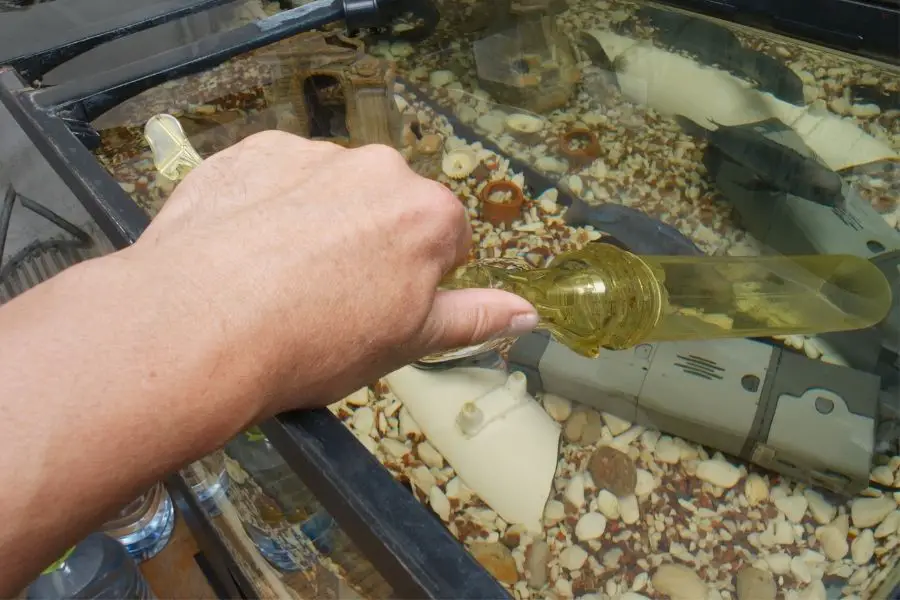Anchor worms are a common crustacean copepod parasites. These worms can infect and cause disease or even kill your aquatic life forms in the aquarium.
Anchor worms will mainly infect freshwater fish, mostly the wild-caught and pond-raised species.
Lernaea infections are high, mainly in the summer months, and occur more in slow-moving or still waters.
There are approximately 110 species of Lernaeids [ lernaean and lernaean like parasites]. Among them, one of the most common parasites to be seen is Lernaea cyprinacea.
You can see this infection commonly in freshwater fish like koi, common goldfish, or Carp. Still, these parasites can infect other fish species and cause them serious harm leading to death.

Does salt kill anchor worms?
Jump To
Yes, adding salt into the water can kill the anchor worm.
If your aquarium has these worms, adding salt is a very effective method. But, it is not the best treatment.
Research has shown that the anchor worm’s eggs will not develop into adulthood at a high salinity level.
Anchor worm’s life cycle span around 18 to 25 days, so keeping your aquarium’s water salinity levels high for around 30 days would eliminate the possibilities of these worms surviving.
Always get some advice from an aquarium expert before doing this treatment because adding salt into the water may harm some of your aquatic animals.
Some species of fish can’t survive at high salinity levels. If your fish could stand such high salinity levels, add salt to the water as recommended to achieve a 4.8 ppt concentration.
Make sure that you have dissolved all the aquarium salt. Keep in mind that not to add all of this at once. Best if you could add in small quantities rather than a heavy dose of salt.
How to identify anchor worm infection
These parasites mate during the final free-swimming [copepodid] stage of growing.
The female will burrow in the flesh of the fish after mating. Then it will transform into a wormlike form, commonly seen with a portion hanging from the fish body. Below are a few symptoms of anchor worm infection.
- Anchor worms. You can see them through your naked eye.
- Frequent rubbing.
- Fish body getting inflated.
- Tiny white-green or red worms in wounds

Anchor worm life cycle
Anchor worms can spread directly from fish to fish. The complete life cycle can take about 18 to 25days, where it can use only a fish or an amphibian to develop from egg to adult.
These parasites have different stages during their development where they will be living off and on the fish.
Once the male and female have completed the reproduction process, the male parasite dies. The female parasite will bore into the host tissue.
The female parasite will then use a large anchor on her head to permanently stick into the host body.
Once the female parasite develops into an adult, she will then, within 24 hours, start to release the eggs from a pair of sacs.
The released eggs will hatch within 24 to 36 hours. A female parasite can produce up to 250 batches every two weeks up to 16 weeks at temperatures warmer than 25 Celsius.
The newly hatched nauplii are free-living [not parasites] and have three developing stages within four days.
They molt into the first copepodid stage, developing into a parasite and attaching to a host, mainly on the gills.
For the next seven days, these parasites will have four different copepodid stages. This stage can usually see the parasite in the gills, but the parasite does not permanently attach to the host.
In the final stage, the male will remove itself from the fish, where the female will remain in the fish or move into another host. Adult males die within 24 hours.
For the parasite to develop and complete the life cycle, they need to have water temperatures between 26 to 28 Celsius.
If the water temperature falls below 20 Celsius, the young lernaean will not develop, and if the temperature drops further to 14 Celsius, the female parasite cannot reproduce.
How to use a salt dip for anchor worm
It is very tempting to pull the parasite off the fish. Do keep in mind that removing these parasites correctly with a fish under sedation must remove the entire parasite entirely from the feeding end.
Here are the steps for treating your infected fish using salt and a puller.
Step 1
Add four tablespoons of recommended aquarium salt for one gallon of freshwater. You can use any brand of aquarium salt to do this treatment, or you can use rock salt if you do not have a big budget.
Step 2
Put your infected fish into salt-concentrated water for about 30 minutes.
Step 3
You must manually remove these parasites.
You can do this by holding the fish in your hand and removing the worms off with a pair of tweezers. Make sure that you have a steady hand when doing this part.
The slightest mistake might harm your fish or break the worm in the left half still attached inside the fish. Keep in mind that fish can not breathe outside of water, so dip the fish into the water now and then.
Step 4
Leave the infected fish in a separate tank for about 3 to 5 days using the salt treatment.
Still, after treating the fish, if you see more anchor worms in the fish, the following solution is that you can treat them with methylene blue for another 3 to 5 days with a 100% water change.

How frequently should you use salt dip?
Salt dipping is purely based on the aquatic animal’s health in your tank. You can give them around 1 to 2 saltwater dips every two weeks.
Other ways to treat anchor worms?
There are several types of treatment methods out there in the market for anchor worm infestation. Here are a few of the best treatments sorted below for your reference,
Potassium Permanganate
Potassium Permanganate is the best medicine out there for your anchor worm infestation.
It would be best to make this solution with distilled water because the organic matter in the water will reduce its efficiency.
Potassium Permanganate is an oxidant, and if you add this medicine directly to the tank, waste particles will use up the oxidative energy before potential parasites get affected.
This treatment is prepared in a ratio of 4 mg/l for up to 4 hours or 10mg/l up to 30 minutes. During the time of treatment, this solution has to retain the purple discoloration.
Due to overdosing implications, the fish should be look over constantly.
Increase your water quality.
Keeping your aquarium water clean will also reduce the chances of an anchor-worm infestation because these parasites prefer still, slow-moving water environments.
Overcrowded tanks are a haven for anchor worms. Always be mindful of having a good tank set up with a quality filter, and doing regular water quality check-ups will reduce the chances of your aquatic animals getting infected by these parasites.
Diflubenzuron [Dimilin X]
Diflubenzuron is a well-effective treatment for anchor worms. It works by disputing growth during molting. When the parasite is most vulnerable, this treatment will affect both young and adult parasites.
Quarantine and inspect the fish.
You must never add the newly bought aquatic animals directly to your aquarium. If you do so, it will enable chances for new parasitic organisms to move to your tank.
The best way is to quarantine the new fish in a separate tank for few days and observe the behavior before adding them.
Microbe-Lift
Microbe-lift is another effective method used in these parasitic organisms. You can use this solution in any water above 40 Faranhite. Always keep in mind that you have to use this as directed, and no harm should occur to the biological filtration.
Feed your fish with good nutrients
Feeding your fish with good nutrients is very important; like humans, every living creature needs proper nutrients to thrive.
Ensure that you provide your fish with the right mixture of protein, fats, carbohydrates, vitamins, and minerals to have a healthy immune system, which will help them fight against parasites and secondary infection more efficiently.
Can anchor worms kill fish?
Yes, an infestation of these parasitic species could lead your fish into severe harm or death. These parasites can give severe pain to the affected fish.
The wounds of anchor worm bites will provide secondary bacterial and viral diseases. That happens through skin damage done through the fish’s body when the parasite burrows into the flash.
In a severe infestation in the gills, the parasite can kill the fish.
Related questions
How long do anchor worms live?
Adult female anchor worms can live up to 30 days, where the male-only lives for 24 hours in the host.
Does Microbe-Lift kill anchor worms?
Yes, this is one of the most known and well-affected treatments out there in the market for these parasites.
Can Anchor worms attach to humans?
No, these parasites are not harmful to humans.
How long can anchor worms live without a host?
A fully developed parasite can live up to two weeks without a host, where a newly born parasite can only live for one to two days without a host.
Read Next: Tiny Worms In Saltwater Aquarium; Easy Ways to Get Rid Of Them
